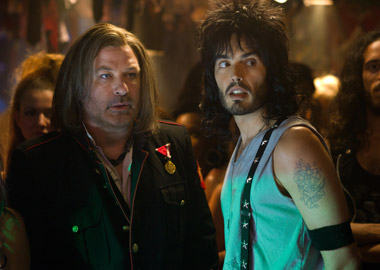Over dinner not long ago, I had a conversation with a friend about the linguistic prowess of British authors. Perhaps it has something to do with their Shakespearean legacy or the varied accents of the land, but Brits seem to have a natural affinity for wordplay. And while rhyming slang and puns are one thing, there’s also a bit of a tradition for the wholesale creation of new languages. Think of Tolkien’s variants of Elvish and you’ll begin to get a picture of how seriously some authors take their characters’ words.
But while Tolkien may be one of the most thorough of creators, I’ve always been particularly impressed with Anthony Burgess’ Nadsat—the Russian-derived argot the author and linguist created for the teenage hoodlums of his novel A Clockwork Orange. A marbles-in-the-mouth mix of English and Slavic sounds—words like “crast” (robbery) and “tolchock” (to hit) and “chelloveck” (person)—it is far from a complete lexicon, but the words it does bring to the table add immeasurably to the story they help tell. Without Nadsat (the word itself derives from a suffix for teenaged or juvenile), Burgess’ story would still be strong, but it would not be told by the young men at its heart.
Stanley Kubrick’s 1971 film of the novel—playing this week as part of Cinemark’s Classic Series on July 11—doesn’t use Nadsat quite as thoroughly as the book, but it’s still a defining element of the film’s tone, making Burgess’ alternate England shift a bit closer to Stalingrad. A young Malcolm McDowell stars as Alex, the ultra-violent leader of a small gang of thugs who use petty crime as a means of thrill-seeking. When he’s arrested, the totalitarian government offers him a choice: become a subject for the new Ludovico technique, which attempts to “cure” violent tendencies in its subjects by means of an intense aversion therapy. Even viewers who haven’t seen Kubrick’s film will recognize the method: with his eyes held open, the subject is shown a film montage of atrocities as a drug cocktail induces a violent physical nausea.
A pawn in a larger game, the “rehabilitated” Alex is taken in by a man intent on proving that the Ludovico technique is just the government’s first move toward a larger system of thought control. There are twists and turns right through the film’s iconic last frame, all of them made richer by Burgess’ rich text. The example of A Clockwork Orange is one that all dystopian, alternate-reality, or science fiction films should take to heart: it’s not enough to simply make up new words; if you want them to add to your story, make them mean something.
*
Also this week: A possibly hilarious musical makes its way from Broadway to the silver screen as Rock of Ages plays across the region. Somehow, this extravaganza of ’80s-era music has attracted a panoply of stars to tell its story of young Hollywood dreamers, played by Julianne Hough and Diego Boneta (90210). On board to help the lovers are Tom Cruise as rock icon Stacee Jaxx (credit where credit is due: they nailed that name) and Alec Baldwin as a long-haired club owner whose sun has begun to set.
The humans are directed by Adam Shankman (Glee); the real stars, however, are the songs. Much like the much-ballyhooed Mamma Mia used the songs of ABBA to push its story forward, Rock of Ages uses a soundtrack that would be at home in any candy-apple Camaro: Def Leppard, Journey, REO Speedwagon, and Poison are all on the bill. It should be one heck of a show.
Jack Brown can be reached at cinemadope@gmail.com.



